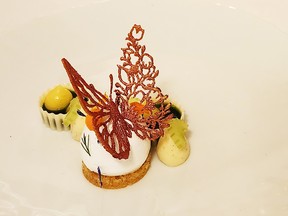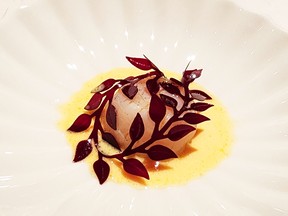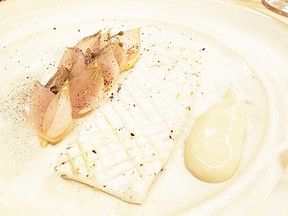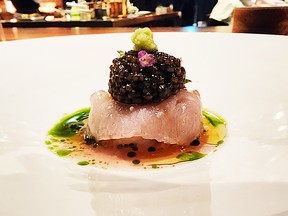Copenhagen’s Sollerod Kro and Geranium justify reputations, Stockholm’s Frantzen in a class all its own and Restaurant Mota sure to be the next gift to food enthusiasts

Reviews and recommendations are unbiased and products are independently selected. Postmedia may earn an affiliate commission from purchases made through links on this page.
Article content
Knowing and deciding where to go and what to try for any restaurant is almost as important as the ability to comprehensively evaluate your experience. It seems that many people — particularly the uninitiated — are primarily concerned with being “seen” in the “right” places with the “right” people. Such self-appointed foodies are easy to identify — they make multiple social media posts from a single restaurant visit. It’s really quite pathetic, added to the frivolous hashtags and mentions, even sprinkled with a few selfies. Talk to anyone who fancies themselves a foodie and they’ll surely cite The French Laundry, Noma, Asador Etxebarri or Eleven Madison Park. Public shortlists have become bibles for this cohort, while less publicized places such as Da Vittorio, Cheval Blanc by Peter Knogl, Waldhotel Sonnora and Regis et Jacques Marcon are cemented in the private bibles of true enthusiasts. Well, herein hide two places we’re happy to recommend among the latter. (Chef groupies, you can thank us later.)
Advertisement 2
Story continues below
Article content
On our first night in Copenhagen, some very well-experienced friends of ours went to Noma and when we asked them, “How was it?” both responded, “It was good.” But if the words were not enough to make the point, their voices both pitched upward on the word “good,” as if trying to convince themselves. When they reciprocated our query — “How was Sollerod Kro for you guys tonight?” — we responded emphatically, “It was unf—ing real.”
Article content

Imagine what it takes to transit from your Toronto home to a Copenhagen hotel, then neglecting to budget an extra 25 minutes travel time each way to visit Sollerod Kro simply because it isn’t “cool” enough. We happen to think that an establishment that’s been around since 1677 and currently houses the chef (Brian Hansen) who won the most recent Bocuse d’Or — the world’s most prestigious cooking competition — is, in fact, very cool. With a small pond out front surrounded by naked trees from the cold winter, the short, rectangular white historic house features its name adorned in old-world letters from end-to-end above the dining room windows, all lit-up by ground lights. Around the corner is the entrance, an aside to a beautiful courtyard with windows that look into the kitchen and the cooks dashing in and out of the kitchen’s side door. Organized chaos. By that moment, the evening had already paid for itself, and by the end of the night, they even gave us both a five-pound Sollerod Kro condensed encyclopedia. Now that, is very cool!
Article content
Advertisement 3
Story continues below
Article content
Our second evening took us to Stockholm, where Frantzén was the experience of that night and another restaurant cemented in the bible of any true enthusiast.

It’s an extremely highly regarded 23-seat experience but, ironically, a relatively well-kept secret in the world of three-star Michelin establishments. Zen is their satellite location in Singapore, which also has three stars. If that isn’t indicative enough, we’ll simply say this: Frantzén is truly in a class of its own even relative to every other three-star restaurant we’re eligible to speak on (around half of the 144 in existence).
By Friday evening, we were back in Copenhagen for a meat-free menu at Geranium, the No. 1 restaurant in the World’s Best 50 for 2022. Although the plants cried out in pain, we laughed, and maybe even shed tears of joy, over the Norwegian scallop dish. It was so remarkable that we demanded a second serving from the kitchen, which Rasmus Kofoed personally served us. I’m so reminded of a memo I posted after my visit to Cheval Blanc by Peter Knogl — to paraphrase: Very few restaurants epitomize the pinnacle of fine dining in a way that transcends time. And its superlativeness is something you sense beyond its constituent elements. Geranium is among those few.
Advertisement 4
Story continues below
Article content
Our final night was a cold 90-minute ride to Nykøbing Sjælland, where Restaurant Mota is located. After about 40 minutes had passed, Howard looked at the meter and said, “This is going to be an expensive ride,” to which Jay responded, “Howard, you make 10 to 20 times more than I do. Try not to be so parsimonious when on vacation.” We looked at each other and chuckled, “parsimonious” being one of the many big words Jay had learned from Howard.

Set inside an old psychiatric ward, we were, befittingly, the first to arrive. As the night progressed, it became evident that there was only one other table with guests. An overheard conversation with the staff revealed their indifference to traffic (as opposed to building something meaningful). This sentiment is culturally rooted and contrary to the North American approach of “make money now” — something we have always highlighted as to why Europe is the motherland of world-class restaurants.
Running the show (once Rene Redzepi’s lead hand) is Claus Henriksen, who took Noma from one star to two stars in 2008. Look up the definition of idiosyncratic and there is a picture of Claus. Accordingly — and, too, from a gustatory perspective — the food is highly memorable. Ingredients include special growths of seaweed and bog oak wood well over 1,000 years old. With few exceptions, if the dishes from this menu were presented at most two-star or three-star restaurants, we would not be in the least surprised. And if presented at three-star Le Bernardin in NYC, which was named the No. 1 restaurant in the world by La Liste (going back to our initial point), Michelin would have to create a four-star or five-star category. An anomalous restaurant experience, but apparently not yet cool enough to be attending, we have a suspicion that Mota will be the next gift serious enthusiasts bestow upon the uninitiated.
Advertisement 5
Story continues below
Article content
Jay to Howard: “I think we are missing something in this review.”
Howard back to Jay: “Oh, yes. El Bulli, the world’s top restaurant for years (now closed), came back to life over the weekend inside Alchemist, which was the very reason for our trip.”

From both to the reader: “When did you first hear of Alchemist? How about El Bulli? Are Ferran and Albert Adria new names to you? If so, study these names — instead of fawning over them because the ‘right’ people put up a flag for you — and we promise we’ll come back to this shortly.”
Howard Levitt is a prominent employment lawyer, judge on several Canadian and international restaurant review panels and a member of the Chevaliers du Tastevin.
Jay Duboulay is an entrepreneur and a judge on several Canadian and international restaurant review panels.
On Instagram: @jayduboulay @howard_levitt
Recommended from Editorial
-

What they’re eating at the world’s best restaurants, from oyster pearls to rendered fudge of deer marrow
-

It’s all about the melt: The cutting-edge science behind the quest for a better non-dairy cheese
Our website is the place for the latest breaking news, exclusive scoops, longreads and provocative commentary. Please bookmark nationalpost.com and sign up for our cookbook and recipe newsletter, Cook This, here.
Article content



Comments